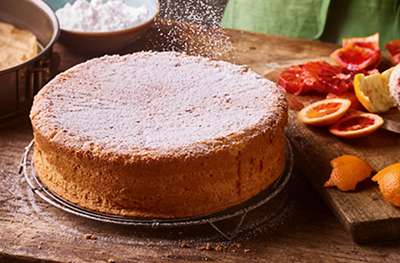0 added
Item price
£2.25Price per unit
£9/kg
Please note, we take every care to ensure the product, allergen and recipe information displayed is correct. However, should a product be unavailable, alternatives may be displayed and/or a substitution provided. If you have an allergy or intolerance, please always check the product label before use.
Prepare the tin (do this while the eggs are whisking if you have a stand mixer). Lightly grease a 23cm round cake tin, at least 6cm deep. Add a little flour, turn the tin to coat, then tap out the excess. Line the bottom with a circle of baking paper.
Using a stand mixer with the whisk attachment (or a large bowl and electric hand mixer), beat the eggs for 5 minutes, or until thickened and lighter in colour. Add the vanilla.
Preheat the oven to 200°C, gas mark 6. Gradually add the sugar in a fine stream and beat for 15 minutes more, or until thick, fluffy and doubled in volume. Don’t whisk fast or you’ll end up with fake bubbles that deflate. Start low, then turn up to medium. Whisk until the ribbon stage, when a trail of mixture sits clearly on the surface for a couple of seconds if you lift the whisk out.
In a separate bowl, sift together the flour and baking powder. Add the salt. Remove the egg and sugar mixture from the stand mixer. Slowly add the dry ingredients to the wet mixture in 3 or 4 stages, gently mixing in by hand with the wire whisk attachment after each addition. If using a hand mixer, remove the beaters and use one in your hand.
Add the lemon zest, if using. Don’t overmix or the batter will deflate. Pour into the prepared tin. Bake for 10 minutes, then lower the heat to 180°C, gas mark 4 and bake for 20 minutes more. A skewer inserted in the centre should come out clean.
Turn the cake (still in its tin) upside down and place on a cooling rack for about 1 hour. This helps stop the cake from deflating. Once cool, carefully slide a small, serrated knife down the side and saw round the edge to loosen. Remove the cake from the tin and place back on the wire rack (right way around) until cold.
Serve with a dusting of icing sugar, whipped cream or Greek yogurt and seasonal fruit or fruit compote. This will be deep enough to split in 2 or 3 (using a gentle sawing motion with a bread knife) and layered with buttercream, cream or whatever you prefer, if liked.
More ideas for leftover whole eggs.
Toad in the hole
A great way to use up a couple of eggs in a meal. Sausages are traditional, but you can also make a version using leftover roasted vegetables, baked into the batter.
Try a frittata
Such a useful dish for using up lots of eggs, plus all sorts of other leftovers. It will keep for 3 days covered in the fridge and can be enjoyed for breakfast, lunch or supper. For inspiration see waitrose.com/recipes.
Freeze them
If you need to use up eggs but have no immediate use for them, freezing works brilliantly. Freeze the yolks and whites separately, if desired, for flexibility once defrosted. I use a silicone ice cube tray, then decant the frozen blocks into a freezerproof bag. Freeze for up to 1 month and defrost, covered, in the fridge.
Typical values per serving when made using specific products in recipe
Energy | 864kJ/ 205kcals |
|---|---|
Fat | 4.2g |
Saturated Fat | 1.3g |
Carbohydrates | 34g |
Sugars | 22g |
Fibre | 0.6g |
Protein | 7.5g |
Salt | 0.6g |
Book a slot to see product availability at your nearest Waitrose & Partners store
0 added
Item price
£2.25Price per unit
£9/kg0 added
Item price
£2.00Price per unit
40p each0 added
Item price
£3.80Price per unit
63.3p each0 added
Item price
£4.05Price per unit
£62.31/kg0 added
Item price
£3.00Price per unit
£3/kg0 added
Item price
£1.30Price per unit
£8.13/kg0 added
Item price
£1.90Price per unit
£5.43/kg0 added
Item price
£1.90Price per unit
47.5p each0 added
Item price
£2.65Price per unit
£2.65/kg0 added
Item price
£1.65Price per unit
£5.50/litre0 added
Item price
£2.80Price per unit
46.7p each